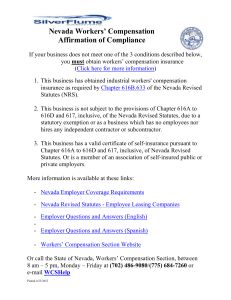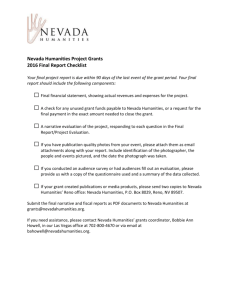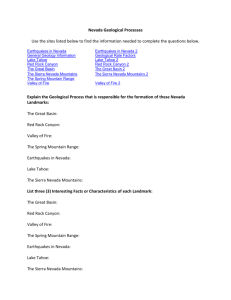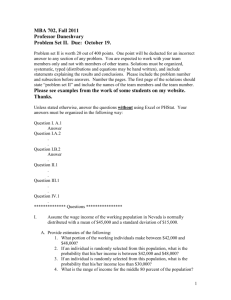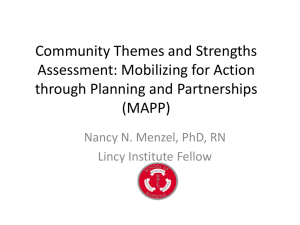Nevada ABC Book Facts Outline - Mrs. Schmidt`s Classroom Site
advertisement
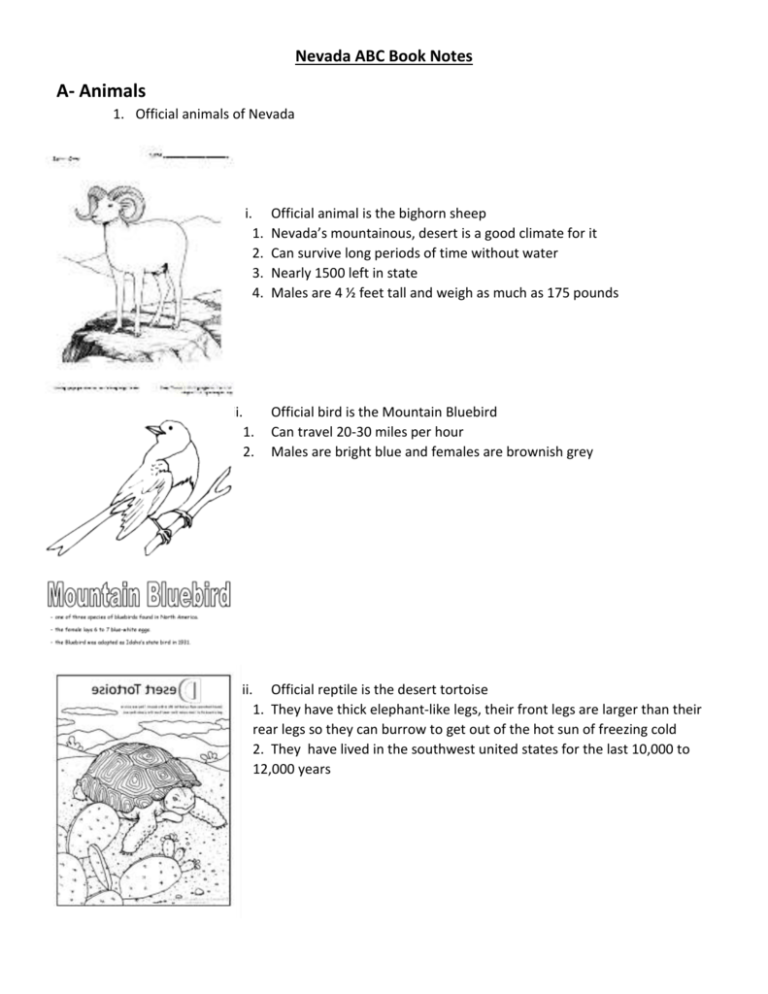
Nevada ABC Book Notes A- Animals 1. Official animals of Nevada i. 1. 2. 3. 4. Official animal is the bighorn sheep Nevada’s mountainous, desert is a good climate for it Can survive long periods of time without water Nearly 1500 left in state Males are 4 ½ feet tall and weigh as much as 175 pounds 1. 2. Official bird is the Mountain Bluebird Can travel 20-30 miles per hour Males are bright blue and females are brownish grey ii. iii. Official reptile is the desert tortoise 1. They have thick elephant-like legs, their front legs are larger than their rear legs so they can burrow to get out of the hot sun of freezing cold 2. They have lived in the southwest united states for the last 10,000 to 12,000 years B- Battle Born 1. Nick name of Nevada 2. Nevada became a state on October 31,1864, during the Civil War 3. Nevada supported the Union or northern states 4. Nevada became a state just in time to help re-elect Abraham Lincoln 5. Miners at the Comstock kept up on war news from the telegraph 6. Fired cannons to celebrate Union victories 7. Nevada’s counties, Lyon and Lander and the city of Reno were named after Union officers that died in the Civil war C- Counties and Capital City 1. Nevada has 16 counties i. When Nevada became a territory on November 25, 1861, the following 8 counties were established 1. Churchill, Lander, Humbolt, Douglas, Storey, Washoe, Esmeralda, and Lyon counties ii. Then the flowing counties were added 1. Nye in 1864, Lincoln in 1866, lko and White Pine in1869 Eureka in 1873, Clark in1908, Mineral in1911, Pershing in1919, iii. Clark County has the largest population with 1,375,765 people iv. most square miles=Nye County with 18, 147 square miles 2. Nevada has 1 independent city which is Carson City which is our state capital i. Carson City was founded 1858, settled by ranchers. ii. Carson City is named for the famous frontiersman and scout Christopher "Kit" Carson. iii. Following the discovery of gold and silver on the nearby Comstock Lode in 1859, Carson City became a thriving city. iv. Carson City was confirmed as Nevada's permanent capital in 1864, when Nevada became a state D- Donner Party a. In April 1846, 89 emigrants with 20 wagons left Springfield, Illinois, and headed west for California i. Led by brothers, Jacob and George Donner b. Tried a new and supposedly shorter route to California. i. trail guide named Lansford Hastings ii. Hastings claimed there was an easy passage through the rugged Wasatch Mountains iii. Rough terrain and numerous delays iv. The “shortcut” to California had cost them many wasted days c. On October 28, a heavy snowfall blocked the high mountain passes i. Became trapped by heavy snowfall high in the Sierra Nevada Mountains. i. Some resorted to cannibalism to survive the winter ii. only half, 45 people, of the original 89, reached California the following year. E- Explorers 1. Escalante and Dominguez i. Spanish priests chosen to explore and find a new route from Santa Fe to Monterey and learn about Native people in area ii. Explored with party of 12 iii. Claimed to have found a large river they called San Buenaventura that started in Utah and believed to end near the Pacific Ocean iv. Other explorers went looking for the San Buenaventura but it was never found 2. Joseph Walker i. Led many explorations across Nevada, looking for furs ii. Did not get along with the Native Americans 1. The first battle in Nevada between whites and Indians was between Walker ‘s party and the Paiute Indians 2. Battle made it hard for other explorers and settlers who came to Nevada 3. John C. Fremont i. The most famous explorer of our state ii. As an army officer, his job was to map the southwest 1. Called the “Pathfinder” 2. First to make correct maps of this region 3. Maps helped other settlers iii. On his travels though Nevada he named many important lakes and rivers, including: Humboldt River, Pyramid lake, Walker River, Walker Lake and the Great Basin iv. His writing proved once and for all that the San Buenaventura River did not exist F- Flag 1. Official colors of Nevada are blue and silver 2. 4 different flag design changes until the final one was adopted in 1991 3. Two branches of Sagebrush (state flower) 4. The words “Battle Born” are a reminder that Nevada became a state during the Civil War 5. The silver star represents our state mineral G- Great Basin National Park 1. Established in 1986 2. Very large land region in Nevada 3. Covers more than half of our state and parts of Utah, Oregon, Idaho, Wyoming, and California 4. Called the “Cold Desert” 5. Wheeler Peak is located in the center of the basin and is the state’s second highest peak 6. Lehman Caves is within the National Park and its cave is made of marble and limestone H- Hoover Dam 1. Originally called the Boulder Dam 2. The Dam was created to slow the Colorado River, and prevent floods, but the most important was to generate electricity for farms and homes 3. Took four years to be built (finished sooner than thought) 4. Families moved to Nevada for the men to work on the Dam (needed money after the Great Depression) 5. More than 13,000 men worked to build the Dam 6. The work was very dangerous and men were hurt and even died 7. Building a cement wall between two steep canyon walls was an engineering wonder 8. Tons of steel and concrete were used to make the Dam 9. The wall of the dam stands 726 feet high and 1,244 feet across 10. Today the dam brings thousands of visitors to Nevada each year 11. Large generators pull water from the Colorado River to produce electricity, which is sent to Nevada, California, and Arizona 12. Lake Mead was created by the Hoover Dam and is the largest man-made lake in the country 13. The dam was completed on May 15, 1938 including the highway on top of the dam that connected Nevada to Arizona I- Ichthyosar 1. Our state fossil 2. Fish-like lizard that was over 55 feet long and weighed thousands of pounds 3. Lived around the same time as dinosaurs 4. Dr. Charles Camp discovered the remains in 1928 5. Many fossils have been found in an old mining town of Berlin J- J- Jobs 1. Tourismi. Most visited place in the world ii. Three mile street, “the strip”, enormous hotels, special decorations and themes iii. Entertainment: shows, roller coaster, magic shows, concerts, amazing restaurant’s iv. First state to legalize gambling (in 1931) which is why people wanted to come to Nevada v. Thousands of Nevadans work in hotels, casinos, and restaurants vi. Tourists spend a lot of money in Nevada, which helps our state build a strong economy 2. Modern Miningi. Still very important part of Nevada ii. Minerals found in Nevada have made a difference in transportation, communication, electronics, engineering, and medicine iii. Copper, molybdenum, barite, mercury, diatomite, magnesia, perlite, gypsum, and fluorspar are some of the minerals found in our soils iv. Nevada has been the largest silver and gold-producing state v. When mines close, mining companies level the land and plant trees and grasses 3. Ranching and Farmingi. Some ranches are large in Nevada, but most are small, with less than 500 head of cattle ii. Ranches sold cattle for beef and sheep for wool and meat iii. Farms grow corn, alfalfa, and garlic seed and produce many dairy products 4. Alternative Energyi. Nevada is one of the best places in the world to collect solar energy ii. Many small business, public buildings and schools are producing their own solar energy iii. Nevada’s geothermal output is second to California. 1. It generates 7% of Nevada’s electricity from local renewable sources and will create more than 2,500 jobs and generate $310 million in revenue each year iv. Wind energy is in the stage of development and has the potential to meet more than half its electricity needs K- Kit Carson Trail 1. Between 1842 and 1847, Kit Carson guided John C. Fremont’s expeditions from the Rocky Mountains, the Great Basin, and into California. He played a key role in opening the West to immigrants from the United States. 2. Old Spanish, The Santa Fe Trail, and Death Valley trails led immigrants through the southern part of the Great Basin. 3. The Bartleson-Bidwell, Donner, and Oregon Trails led immigrants through the northern part of the Great Basin. 4. The immigrants faced many dangers like the weather and starvation. L- Lakes 1. Pyramid Lake- located in north western Nevada. It is located on the Paiute reservation and was the scene of many battles involving the Native American and White settlers. 2. Lake Tahoe- Lake Tahoe is located high in the Sierra Nevada Mountains. The lake is made up of melting snow from the harsh winters. Lake Tahoe is divided by California and Nevada. 3. Walker Lake- Walker Lake is located southeast of Carson City. It was once part of Lahontan Lake until it began to dry up and split into two lakes. 4. Lake Mead- Lake Mead is the biggest man-made lake in the United States. It is a reservoir that hold water from the Colorado River before it goes through the Hoover Dam. The water from Lake Mead is used for recreation and also to help generate electricity by flowing through Hoover Dam. M- Mountain Men 1. Mountain men were trappers that spent long, lonely periods of time in the wilderness trapping furs and hunting food. a. Each year Mountain men would gather and trade for supplies at an annual Rendezvous. b. Jedediah Smith, Peter Skene Ogden, Joseph Walker, Jim Beckworth, and Kit Carson were famous mountain men who helped settled the west. They often worked as guides for armies or traded with Native American tribes. c. Jedediah Smith 1. 1st white man to travel through Nevada looking for rich fur trapping areas 2. led a 15 man expedition from Utah to California 3. looked for but never found the San Buenaventura River 4. attacked by grizzly bear that tore off is ear and his friend sewed his ear on upside down 5. was killed by Native Americans when he was 32 N- Native Americans 1. Desert archaic people lived in the Great Basin over 10,000 years ago. 2. The Lovelock Cave people were hunter-gatherers who lived in Nevada over 2,500 years ago. 3. Native Americans wrote on cave walls. These writings and drawings are called petroglyphs. 4. The Anasazi people made pit houses to keep them cool in the winter. They also mined turquoise and other minerals and traded them for goods. 5. Native Americans used the “Three Sisters” Garden to help grow food in poor soil. 6. Native Americans now live on land called reservations. O- Ore 1. Ore is rock, dirt, sand, or gravel that has minerals it. 2. During the Comstock Lode, gold and silver ore were found. This led to a population boom in Nevada. 3. Gold mining in Nevada, a major industry, and one of the largest sources of gold in the world. a. Nevada currently mines 79% of all the gold in the United States, which is equivalent to 5,640,000 troy ounces (175 t) in 2009. Recorded from 1835 to 2008 totals 152,000,000 troy ounces , worth over US $228 billion at 2011 prices. b. The Comstock Lode, for instance, produced 8,600,000 troy ounces (270 t) of gold through 1959, 4. Many other minerals have been found in the rich ore in Nevada’s land. All this mineral rich ore helped people agree that Nevada would be an important state to have in the United States. P- Pony Express 1. About 80 men were hired rode horses from St. Joseph, Missouri to Sacramento, California delivering mail 2. Riders had to be less than 125 pounds, ranged from ages 11-40, and pledged an oath on a bible. 3. The trip from Missouri to California was 2,000 miles 4. Riders changed horses every 10 to 15 miles at relay stations. 5. There were 29 relay stations throughout Nevada. 6. After 18 months the Pony Express went out of business due to the invention of the telegraph. Population 1. 1859- Basques began settling in Nevada (Basque – person who originally immigrated from the Pyrenees Mountains between France and Spain.) 2. 1863 Nevada’s first constitution was written 3. The Nevada Territory grew quickly over the last half of the 19th century. 4. 1864- Nevada becomes the 36th state 5. James Buchanan created the Nevada Territory a few days before Lincoln took office as the U.S. President. 6. 1866 – Congress adds land to Nevada’s eastern border. 7. 1867- Nevada gets more land from the Arizona Territory. This area becomes Clark County. 8. 1905- Las Vegas is created when lots are sold. County Population d. Clark County 2,000,759 Washoe County 429,908 Lyon County 51,327 Elko County 51,216 Douglas County 46,996 Nye County 42,963 Humboldt County 17,048 White Pine County 10,042 Pershing County 6,749 Lander County 5,941 Lincoln County 5,405 Mineral County 4,653 Storey County 3,935 Eureka County 2,001 Esmeralda County 775 Nevada in 2013 is estimated at 2,788,593 Geography Land area in square miles as of 2010 Nevada - 109,781.18 Persons per square mile, 2010 Nevada- 24.6 Clark County- 7,891.43 Clark County- 247.3 Q- Quarter 1. Carson City Mint 2. Congress decided it would cost too much money to send the Comstock silver to the mint in California -A branch of the United States Mint was built in Carson City on January 10, 1870. 3. In 1894, Chief Melter Hirsch Harris realized that someone was stealing the tiny amounts of gold that were normally found in the silver bars and replacing it with copper. 4. A full investigation was conducted by the U.S. Treasury 5. April 18, 1895 the mint was closed and would never coin money again. 6. Nearly $50 million silver coins were produced in Nevada’s mint during its 23 years of operation. 7. June 1896 the Carson City Mint was allowed to reopen as a precious metal refinery. 8. In 1933 the mint was officially closed so that the country could save money during the Great Depression. State Quarter 1. released January 31, 2006 2. Trio of wild mustangs because Nevada is home to 50 percent of the nation’s wild horses 3. sun rising behind snow-capped mountains 4. bordered by sagebrush 5. Banner reads “The Silver State” 6. Inscribed with “Nevada” and “1864” 7. Engraved by Don Everhart 8. The Great Basin Quarter was released in 2013 R- Railroad 1. 1830 - First talk of a transcontinental railroad started 2. There were two main routes along which people wanted the first railroad to be built. 3. One route was called the "central route". It followed much the same route as the Oregon Trail. It would begin in Omaha, Nebraska and end up in Sacramento, California. The other route was the "southern route". This route would stretch across Texas, New Mexico, and end up in Los Angeles, California. 4. 1862 President Abraham Lincoln signed the Pacific Railroad Act into law. The act said that there were two mainrailroad lines. The Central Pacific Railroad would come from California and the Union Pacific Railroad would come from the Midwest. The two railroads would meet somewhere in the middle. 5. 1863-1869- The railroad was built 6. The Central Pacific Railroad had to blast a number of tunnels through the Sierra Nevada Mountains. The longest tunnel built was 1659 feet long. It took a long time to build the tunnels. They were able to blast around 1 foot per day on average. 7. The majority of the workers on the Union Pacific Railroad were Irish laborers, many who had served in both the Union and the Confederate armies. In Utah, a lot of the track was built by Mormon workers. Most of the Central Pacific Railroad was built by Chinese immigrants. 8. While the Central Pacific Railroad had to deal with mountains and snow, the Union Pacific Railroad had to deal with Native Americans. As the Native Americans realized the threat to their way of life that the "Iron Horse" was going to bring, so they began to raid the railroad work sites. Also, a lot of the land that was "granted" to the railroad by the U.S. government was actually Native American land. 9. The two railroads finally met at Promontory Summit, Utah on May 10, 1869. Leland Stanford, governor of California and president of the Central Pacific Railroad, drove in the last spike. This final spike was called the "Golden Spike" or "The Final Spike". You can see it today at Stanford University in California. 10. 1869 – The first transcontinental railroad is completed S- Symbols and State Seal 1. Nevada’s State Seal, the seal has a lot of symbols i. Mineral resources are represented by a silver miner and his team moving a carload of ore from a mountain on the left. ii. A quartz mill stands at the base of another mountain on the right. iii. Symbols for transportation and communication are telegraph poles and a train steaming across the background. iv. In the foreground are symbols for agriculture - a sheaf of wheat, a sickle, and a plow. v. Nevada's natural beauty is represented by a shining sun rising over snowcapped peaks. vi. The inner circle of the seal displays the motto "All for Our Country" and 36 stars (Nevada is the 36th state to join the Union). vii. The perimeter of the seal states "The Great Seal of the State of Nevada". 2. Nevada’s official State Symbols i. ii. iii. iv. v. vi. vii. viii. ix. x. xi. xii. xiii. xiv. xv. xvi. Bird: Mountain Blue Bird Reptile: Desert Tortoise Colors: Silver and Blue Fish: Lohonton Cutthroat Trout Flower: Sagebrush Fossil: Ichthyosaur Grass: Indian Rice Grass Insect: Vivid Dancer damesfly March: “Silver State Fanfare” composed by Gerald Willis Metal: Silver Precious Gemstone: Virgin Valley black fire opal Semi-Precious Gemstone: Nevada Turquoise Rock: sandstone Soil: Orvada Series Song: “Home Means Nevada” written by Mrs. Bertha Raffetto Tree: Single Leaf Pinion and Bristlecone pine T- Telegraph: 1. Samuel Morse developed the telegraph system from the ideas of joseph Henry and William Cooke. 2. The telegraph system works by sending electronic currents through wires. 3. The current travels through the wire to activate an electromagnet, this electromagnet then causes a bell to strike. 4. Both Henry and Cooke created the telegraph system using the principal of electromagnetism. 5. Morse took their ideas and created a practical 6. 7. 8. 9. 10. 11. 12. system that could be useful to all people. Morse gave a public demonstration of his invention in 1838. In 1843 Congress gave $30,000 to create an experimental telegraph line from Baltimore to Washington D.C., a distance of 40 miles. The first news that was sent through the telegraph system was that Henry Clay was nominated to represent the Whig Party. 1851- Trains were dispatched via telegraph and Western Union went into business Western Union built its first transcontinental telegraph line in 1861. Until 1877 the only quick way to talk to people far away was by using the telegraph. In 1877 the telephone changed the way everyone communicated with one another. U- Universities 1. Nevada is home to more than 50 colleges, universities and technical schools. Since most of the state’s population resides in Las Vegas and Reno, most 2. of the colleges in Nevada are in these two metropolitan areas. 3. The Nevada System of Higher Education is made up of five public Nevada colleges and universities including University of Nevada - Las Vegas, University of Nevada - Reno, College of Southern Nevada, and Truckee Meadows Community College. 4. Other community colleges are located throughout the state. Private schools include Sierra Nevada College and University of Southern 5. Nevada. 6. variety of career colleges in Nevada offer ample opportunities ranging from Pima Medical Institute, Las Vegas to Marinello Schools of Beauty, Las Vegas. 7. The University of Nevada, Las Vegas, which was established in 1957, is known for its hospitality, engineering, and English programs. The university includes the College of Business and Fine Arts and the College for Liberal Arts and Science, which are accredited by the Northwest Commission of Colleges and Universities. It is located on the southern tip of Nevada. 8. The College of Southern Nevada in Clark County is one of the largest public institutions of hi gher education. It has a two year as well as four year degree program in Dental Hygiene. The College of Southern Nevada also provides job training in about 75 different fields and has around 200 degree and technical courses. A degree in hospitality and training with specialization in culinary arts, travel, and tourism also forms a part of the curriculum at the College of Southern Nevada. V- Vote (Government) Like the federal system, Nevada has three 1. independent and co-equal branches of government— executive, legislative, and judicial. Today, the largest of the three branches is the 2. executive branch. There are six "constitutional officers." The people of the state elect each of these officers once every four years. These officers are the governor, lieutenant governor, secretary of state, state treasurer, state controller, and attorney general. The primary responsibility of the executive branch 3. is to carry out the laws, programs and services, and policies of the state as specified in legislation enacted by the Nevada legislature and signed by the governor. The duties of the constitutional officers may be summarized as follows: i. Governor—serves as chief executive of the state. ii. Lieutenant Governor—presides over the Nevada senate and casts a vote in the case of tie, fills any vacancy during the term of the governor, and chairs the commissions on Tourism and Economic Development. iii. Secretary of State—is responsible for overseeing elections, commercial recordings, securities, and notaries. iv. State Treasurer—oversees state treasury, sets investment policies for state funds, and administers the Unclaimed Property Division and the Millennium Scholarship Program, along with the other college savings programs. v. State Controller—is responsible for paying the state's debts, including state employees' salaries; maintains the official accounting records; and prepares the annual statement of the state's financial status and public debt. vi. Attorney General—acts as the chief law enforcement officer, provides legal services to the state and state agencies, and defends or prosecutes litigation involving the state or state agencies. 4. The Nevada legislature is made up of two houses of equal importance—the senate and the assembly. One primary responsibility of the legislature is to pass laws governing the state. A related responsibility of the senate and assembly is to develop and revise, as needed, a fair and equitable tax structure to support the state budget, schools, and other approved expenditures. 5. A supreme court heads Nevada's judicial branch. Under the broad umbrella of the judicial branch are the district courts of Nevada, the city (municipal) courts, and the justices of the peace. W- Weather (and Climate) Nevada has great climatic diversity, ranging from scorching 1. lowland desert in the south to cool mountain forests in the north. i. Its varied and rugged topography, mountain ranges, and narrow valleys range in elevation from about 1,500 to more than 10,000 feet above sea level. ii. Wide local variations of temperature and rainfall are common. The principal climatic features are bright sunshine, small annual precipitation, (averaging nine inches in the valleys and deserts) heavy snowfall in the higher mountains, clean, dry air, and exceptionally large daily ranges of temperature. The mean annual temperatures vary from the middle 40’s in the 2. northeast to about 50° F in the west and central areas and to the middle 60’s in the south. i. In the northeast, summers are short and hot; winters are long and cold. ii. In the west, the summers are also short and hot, but the winters are only moderately cold; iii. in the south the summers are long and hot and the winters short and mild. Long periods of extremely cold weather are rare, primarily because the mountains east and north of the State act as a barrier to the intensely cold continental arctic air masses. However, on occasion, a cold air mass spills over these barriers and produces prolonged cold waves. 3. Summer temperatures above 100° F occur rather frequently in the south and occasionally over the rest of the State. 4. Nevada lies on the eastern side of the Sierra Nevada Range, a massive mountain barrier that markedly influences the climate of the State. 5. Percipiation i. One of the greatest contrasts in precipitation found within a short distance in the United States occurs between the western slopes of the Sierras in California and the valleys just to the east of this range. ii. The prevailing winds are from the west, and as the warm moist air from the Pacific Ocean ascends the western slopes of the Sierra Range, iii. the air cools, condensation takes place and most of the moisture falls as precipitation. iv. A winter precipitation maximum occurs in the western and south-central portions of the State, a spring maximum in the central and northeastern sections, and a summer maximum primarily in the eastern portion where thunderstorms are most frequent. v. The average annual number of days with precipitation of 0.01 inch or more varies considerably; Las Vegas averages 23, Reno 49, Winnemucca 67, Ely 72, and Elko 78. vi. Snowfall is usually heavy in the mountains, particularly in the north. This is conducive to many winter sports activities, including skiing and hunting. Twenty-four hour snowfall can amount to over 45 inches, while seasonal totals of over 300 inches have been recorded. X- eXtra-terrestrial (Area 51) 1. Area 51, also officially known as Groom Lake is a remote detachment of Edwards Air Force Base. According to the Central Intelligence Agency (CIA), the correct names for i. the Area 51 facility are the Nevada Test and Training Range and Groom Lake, though the name Area 51 has been used in official CIA documentation. 2. It is located in the southern portion of Nevada, 83 miles north-northwest of Las Vegas. Situated at its center, on the southern shore of Groom Lake, is a large military airfield. The base's current primary purpose is i. officially undeterm ined; however, based on historical evidence, it most likely supports development and testing of experimental aircraft and weapons systems. 3. The intense secrecy surrounding the base has made it the frequent subject of conspiracy theories and a central component to unidentified flying object (UFO) folklore. 4. Although the base has never been declared a secret base, all research and sightings in Area 51 are Top Secret/Sensitive Compartmented Information (TS/SCI). Y- Yucca Mountain Yucca Mountain is a 1,200-foot high flat-topped volcanic ridge extending six miles from 1. north to south. 2. It is located in Nye county, Nevada, 90 miles northwest of Las Vegas on federally-owned land on the edge of the Nevada Test Site. Yucca Mountain is comprised of "tuff," a rock made from compacted volcanic 3. ash formed more than 13 million years ago. 4. Yucca Mountain has a desert climate and receives about six to seven inches of rain and snow per year. 5. Yucca Mountain is the only site being considered by the Department of Energy (DOE) as a “permanent disposal” site for the United States’ highly radioactive nuclear waste. i. This spent nuclear fuel and high-level waste is currently located at 77 sites across the country and would have to be transported by truck or rail to Yucca Mountain if that site is approved as a geologic repository. ii. The proposed Yucca Mountain nuclear waste repository is a vast and complex project with a history dating back over 20 years. iii. After years of study, the U.S. and most countries around the world have concluded that permanent geologic burial is currently the most acceptable solution for the final disposition of high-level nuclear waste. Other options, such as shooting the waste out into space, are far too risky. 6. People in favor of this site think it’s a good option because it’s in a desert location, isolated away from population centers, secured 1,000 feet under the surface, surrounded by federal land, and protected by natural geologic barriers. 7. People against the project think it’s too risky because Yucca Mountain is in a high earthquake zone and that the surrounding areas and groundwater would be affected. Z- Zzz… (Las Vegas, the city that never sleeps) 1. The city of Las Vegas celebrated its 100th birthday on May 15, 2005. The event celebrated the May 15, 1905 land auction when 110 acres of land in downtown Las Vegas were auctioned off. 2. A 1910 law made it illegal to gamble in Las Vegas. The Nevada Legislature later approved a legalized gambling bill in 1931. 3. The first hotel and casino to open in Las Vegas was the Golden Gate Hotel and Casino in 1906. 4. In 1957, showgirls debuted on the Las Vegas Strip in “Minsky’s Follies” at the Dunes. 5. The famous “Welcome to Las Vegas” sign was created in 1959 by Betty Willis. 6. In 2011, more than 368 million people visited Las Vegas. Compare this to 1970 when a mere 6.7 million people visited the city. 7. More than 19,000 conventions were held in Las Vegas in 2009. 8. In 2011, visitors stayed an average of 3.7 nights. 9. Las Vegas is home to Clark County School District, the fifth largest school district, which currently handles more than 311,000 students. 10. The famous Las Vegas strip is for the most part, not within the city limits of Las Vegas. The majority of the strip is located within Clark County. 11. The Stratosphere Hotel and Tower, at more than 1,100 feet, is the tallest building west of the Mississippi and the fifth tallest building in the United States. 12. A marriage license costs $60 in Nevada. Many couples choose to marry in Nevada because there is no waiting period. 13. Fremont Street was closed to traffic in 1994. The Fremont Street Experience opened in December 1995. 14. In 2013, the Las Vegas Strip’s gaming revenue was $6.5 billion.
